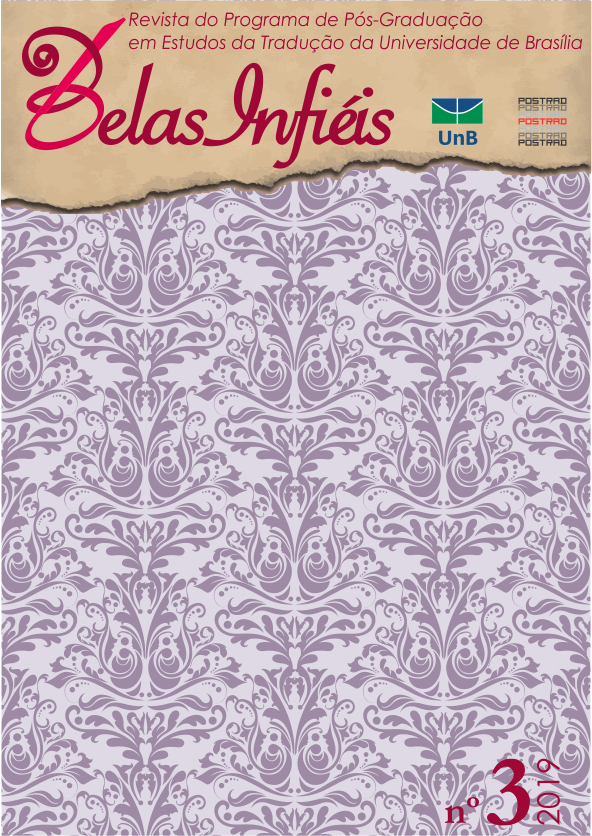Wabi Sabi: Intermediated Textures of Impermanence and Imperfection
DOI:
https://doi.org/10.26512/belasinfieis.v8.n3.2019.26340Keywords:
Intermediation. Transculturality. Translation. Wabi Sabi. Children’s Literature.Abstract
Mark Reibstein and Ed Young’s 2008 picture book Wabi Sabi tells the story of a Kyoto cat in search of the meaning of its name. This award-wining children’s book explores identity through the composition of various layers of meaning and complexity in form and structure, suggesting that an understanding of identity cannot be expressed easily through words alone. This paper begins by examining how the use of a range of storytelling modes including collage, photography, drawing, poetry and prose are combined, inviting the implied child reader to become involved in the intermedial qualities of the text, at the same time as they follow the cat in its journey of self-discovery. Focus then turns to the use of natural, textured materials in the artwork of the picture book, analyzed as a reflection of the concept of wabi sabi; a Zen-Taoist philosophy that draws attention to the value and beauty of impermanence and imperfection. This alternative way of thinking about identity proposes that self-knowledge is attained through an encounter with simple, rustic and natural phenomena, as opposed to the industrialized newness and perfection so often idealized in Western civilization. The third section of the paper explores how the text, with its capacity to incorporate both Western and Japanese modes of storytelling, is a form of cultural translation. Not confined to the traditional mode of translation from one language to another, or from source to target text, this picture book, in its use of haiku and Japanese calligraphy, its glossary and its explanation of wabi sabi, invites the reader to consider how translation shares ideas across and between time and cultural context.
Downloads
References
BASSNETT, Susan. Translation Studies. 4 ed. Routledge, 2014.
BHABHA, Homi K. The Location of Culture. 2 ed. Routledge, 2004.
CONWAY, Kyle. Cultural Translation. In: GAMBIER, Yves (ed.); DOORSLAER, Luc van (ed.). Handbook of Translation Studies. v. 3. Amsterdam: John Benjamin Publishing Company, 2012. p. 21-25.
FEATHERSTONE, Mike. Global Culture: Nationalism, Globalization and Modernity. Sage, 1990.
HAKUTANI, Yoshinobu. Haiku and Modernist Poetics. Palgrave MacMillan, 2009.
HERZOGENRATH, Bernd. Travel in Intermediality, An Introduction. In: HERZOGENRATH, Bernd (ed.). Travels in Intermedia(lity): Reblurring the Boundaries. Darmouth College Press, 2012. p.1-14.
JUNIPER, Andrew. Wabi Sabi: the Japanese Art of Impermanence. Tuttle Publishing, 2011.
KAWAMOTO, Koji. The Use and Disuse of Tradition in BashÅ's Haiku and Imagist Poetry. Poetics Today, Durham, NC, v. 20, n. 4, p. 709-721, winter, 1999.
KLINGBERG, Götte. Children’s Fiction in the Hands of the Translators. Liber/Gleerup, 1986.
PYM, Anthony. Exploring Translation Theories. Routledge, 2014.
REIBSTEIN, Mark; YOUNG, Ed. Wabi Sabi. Little Brown and Company, 2008.
SHAVIT, Zohar. Poetics of Children’s Literature. University of Georgia Press, 1986.
YASUDA, Kenneth. Japanese Haiku: Its Essential Nature and History. Tuttle Publishing, 2011.
Downloads
Published
How to Cite
Issue
Section
License
Given the public access to this journal, the texts are free to use but requires the recognition of the original authorship and initial publication in this journal to be properly stated.
 The journal allows the use of works published for non-commercial purposes, including the right to submit the work to publicly accessible databases. Published contributions are the sole and exclusive responsibility of the author(s).Â



















